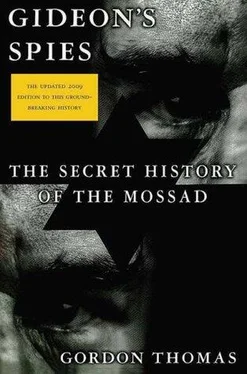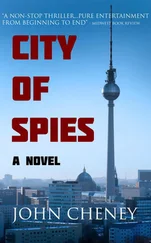Gordon Thomas - Gideon's Spies
Здесь есть возможность читать онлайн «Gordon Thomas - Gideon's Spies» весь текст электронной книги совершенно бесплатно (целиком полную версию без сокращений). В некоторых случаях можно слушать аудио, скачать через торрент в формате fb2 и присутствует краткое содержание. Город: New York, Год выпуска: 2009, ISBN: 2009, Издательство: Thomas Dunne Books, Жанр: История, на английском языке. Описание произведения, (предисловие) а так же отзывы посетителей доступны на портале библиотеки ЛибКат.
- Название:Gideon's Spies
- Автор:
- Издательство:Thomas Dunne Books
- Жанр:
- Год:2009
- Город:New York
- ISBN:978-0-312-53901-6
- Рейтинг книги:4 / 5. Голосов: 1
-
Избранное:Добавить в избранное
- Отзывы:
-
Ваша оценка:
- 80
- 1
- 2
- 3
- 4
- 5
Gideon's Spies: краткое содержание, описание и аннотация
Предлагаем к чтению аннотацию, описание, краткое содержание или предисловие (зависит от того, что написал сам автор книги «Gideon's Spies»). Если вы не нашли необходимую информацию о книге — напишите в комментариях, мы постараемся отыскать её.
Gideon’s Spies
Gideon's Spies — читать онлайн бесплатно полную книгу (весь текст) целиком
Ниже представлен текст книги, разбитый по страницам. Система сохранения места последней прочитанной страницы, позволяет с удобством читать онлайн бесплатно книгу «Gideon's Spies», без необходимости каждый раз заново искать на чём Вы остановились. Поставьте закладку, и сможете в любой момент перейти на страницу, на которой закончили чтение.
Интервал:
Закладка:
In the month preceding the Los Almos operation, Qiao Shi had seen his power as vice-minister and overall co-coordinator of China’s security services eroded in a series of internal struggles within the Politburo. Finally he was, effectively, demoted to be head of the Chinese Secret Intelligence Service’s foreign intelligence branch. “The reason he was given was that the country’s need in global intelligence gathering required more than one man to head up those requirements,” a source told the author.
Qiao Shi was told that operations in place under his directions would remain his to control. He remained in post till June 2006.
The entire Los Alamos operation was given “total deniability” status by both Washington and Tel Aviv. The author was told in July 2006 by a former Canadian diplomat with knowledge of the operation “that publicity would have seriously damaged ongoing trade relations between both countries!”
Under Qiao Shi’s direction, the Los Alamos theft had been prepared and carried out by PLA-2, the Second Intelligence Department of the People’s Liberation Army General Staff. Its multifunctions include tasking military attachés at Chinese embassies abroad and organizing clandestine operations. For months he had planned it in his office inside Zhonganhai, the government compound where the Chinese leadership lived in splendid isolation. As part of that planning, Qiao Shi had called upon CSIS’s long-standing relationship with Mossad, which went back to their original collaboration in Africa (see chapter 13, “African Connections,” pp. 250–2). For Mossad the chance to learn some of the secrets at Los Alamos was too good an opportunity to pass up. Mossad arranged for a team of LAKAM programmers and surveillance experts from its own yaholomin unit to travel to Beijing. They became part of the team that would electronically rob Los Alamos.
The fine-tuning of the operation had been placed in the hands of Wang Tomgye at the Science and Technology Department in the monolithic Ministry of Defense headquarters in Beijing’s Dencheng District. In all, a hundred experts had been brought in to carry out the unprecedented heist. Many were experts in the difficult art of undetected computer hacking. Some of them had learned their skills while working for various companies in California’s Silicon Valley. One by one they had been recalled to Beijing to take up their specialist work for the robbery.
The date was set for May 5, 2004. The target was the high security vault in what was itself Los Alamos’s most secret facility. X-Division was a network of cramped offices on the third floor of the main laboratory building. Guarded by coded swipe cards whose entry numbers changed every day, the most sensitive of X-Division’s data was stored in a strong room that had every device known to U.S. security experts. It was claimed to be more secure than Fort Knox’s gold repositories. Inside the vault was a fireproof bag that could be opened only by using a special password. Inside that were the computer drives. Each disk contained detailed technical information, including how to dismantle the bomb designs created by rogue states like North Korea. They would provide anyone who obtained them with a massive advantage in knowing the nuclear secrets that the United States possessed.
Chinese and Israeli technicians had devised a hacking system that could electronically penetrate all the X-Division defenses. A replica of the Los Alamos vault was specially built in the basement of the Science and Technology Department. Inside the vault’s steel walls was placed a fireproof bag. Inside the bag were put hard drives containing nonsecret information. The task of the hackers was to remove the information without revealing they had done so. They were to do so not from somewhere in Beijing, but at a considerable distance from the Chinese capital. The hackers were dispatched to Shanghai, several hundred miles away. They set to work. When the vault was later opened, there was no evidence the fireproof bag had been penetrated. The team of hackers returned to the basement. With them they brought true copies of the information electronically lifted from the hard drives stored in the bag.
The Chinese planners had worked on the premise that from time to time the hard drives in Los Alamos would be removed from their fireproof bag and placed in a computer they were certain would be inside the X-Division vault. This would either be done to check for a piece of information or to make sure the disks were in perfect working order. In Shanghai, the hackers had waited several days for the disks in the replica vault to be removed and inserted in a computer nearby.
The Chinese and Israeli team had also worked on the premise that at Los Alamos there was a good chance the hard drives would be left in the computer in an emergency. To create one, CSIS agents would light a brushfire that, given the prevailing wind direction, would sweep toward Los Alamos.
The next test took place in the Luzon Strait between Taiwan and the Philippine Islands. This time the hacking team was on board a Chinese nuclear-powered submarine of the blue-water fleet of the People’s Liberation Army-Navy. The submarine rose close to the surface, and the hackers went about their business. Once more they succeeded in electronically penetrating the replica vault in the Beijing basement. They returned to report their success to Qiao Shi.
Everything was ready. The team of hackers arrived in Puerto Penasco at the upper reaches of Mexico’s Golfo de California. They were supplied with fishing equipment and boxes of tackle. Their journey to the port had been a long one. From Hong Kong they had flown into Mexico City and then driven to Puerto Penasco. Waiting for them was their rented fishing boat. Hidden on board, placed there by a CSIS agent in Mexico, was their equipment for hacking. They set to sea, ostensibly on a fishing trip.
With Los Alamos evacuated as the brushfire threatened to engulf the facility, the team set to work. Using the coordinates they had been provided with, the hackers had homed in on the X-Division vault at Los Alamos. Just as they had waited in Shanghai for the right moment, so they had electronically lifted all the data from the hard drive disks in the fireproof bag. A week later, the team was back in Beijing.
No one would ever establish how the disks were subsequently found behind the photocopier. Was there a Mossad or CSIS agent inside Los Alamos? Late in November 2002, a meeting was held at Los Alamos to discuss the possibility. Gathered in a conference room in X-Division was George Tenet, then director general of the CIA; Britain’s current MI6 chief, Dearlove; Director Freeh of the FBI (soon to lose his job); and Los Alamos security chief, Eugene Habinger. There was a consensus the theft had changed, almost certainly for the foreseeable future, the close intelligence links between Washington and London with Israel.
The sheer cold professionalism of the operation had placed CSIS, in Mossad’s mind, as the one service it could rate as an equal. But in the past, the CIA had also worked with the Chinese. In 1984, William Casey, then head of the CIA, had secretly met Qiao Shi and persuaded him to act against the Triads who controlled over 60 percent of New York’s heroin market. Every major American city had its Triad godfather, through whom an increasing amount of cocaine from Colombia and the Golden Triangle in Southeast Asia was marketed by dealers whose lineage went back to the opium dens of the 1800s. Casey had proposed a joint intelligence operation to combat the traffickers who had also started to target students on China’s campuses. Mossad had monitored a meeting in the Mandarin Oriental Hotel in Hong Kong between senior CSIS officers and a team from the CIA, FBI, and the DEA in January 1985. It was another striking example of the hidden links and interdependencies between intelligence services.
Читать дальшеИнтервал:
Закладка:
Похожие книги на «Gideon's Spies»
Представляем Вашему вниманию похожие книги на «Gideon's Spies» списком для выбора. Мы отобрали схожую по названию и смыслу литературу в надежде предоставить читателям больше вариантов отыскать новые, интересные, ещё непрочитанные произведения.
Обсуждение, отзывы о книге «Gideon's Spies» и просто собственные мнения читателей. Оставьте ваши комментарии, напишите, что Вы думаете о произведении, его смысле или главных героях. Укажите что конкретно понравилось, а что нет, и почему Вы так считаете.












